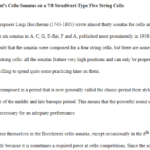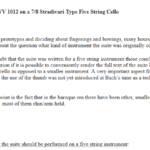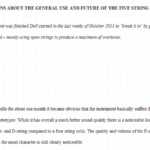- 2015-2-1
- IV. FINAL TESTS AND CONCLUSIONS, PLAYING THE SONATAS BWV 1027 - 1029 ON A FIVE STRING CELLO
- Bach sonatas BWV 1027-1029
Playing the Sonatas BWV 1027-29 on a 7/8 Stradivari-Type Five String Cello
Many musicologists now believe that those three Sonatas were originally written around 1720 as trio sonatas, and that Bach rewrote them in the 1730th for viola da gamba and cembalo.. Lacking any cello sonatas from Bach’s hand, cellists tend to play those pieces on their own instruments. However, a viola da gamba has five to seven strings and is tuned in fourths on the outer strings and in a third in the middle. Any attempt to perform a gamba piece on a four string cello will result in many technical and, therefore, musical problems. Generally to play Bach’s works on different instruments than originally intended presents no stylistic problems, as long as a natural performance is possible. However, it is a very difficult endeavor to do so using an instrument that has at least one string less than the original instrument. Using a five string cello might not be an ideal solution, but the additional string could make a performance easier for cellists to a considerable extent – a bass viol (6-7strings) has a tonal range from D to d’, which is very similar to a five string cello’s range. When playing the piece on a viola da gamba only low positions are being used throughout the entire piece. (The highest frets of a viol are in an area that would be equivalent to the 3rd to 4rth position on a cello.) Played on a four string cello the piece frequently requires the use of the thumb, going up to the d” on the A-string. Often high positions on the D-string have to be used, registers that are not the most favorable ones on a cello, especially on cheaper instruments.
Sonata BWV 1027
(The measure numbers in the Peters edition are consecutive for the movements I/II and III/IV since there is no solid double bar ecxept at the end of the second movement and the fourth movement..Peters numbers are shown left of the slash. The numbers right of the slash are for the Henle edition which counts each movement separately)
I. Adagio:
This movement is not too difficult to be played on a four string cello. However, using a five string cello would save a lot of shifts and only request the use of the low four positions. The cellist can concentrate on the music without having to spend a lot of time practicing difficult shifts.
Highest note on a five string cello is the c” in the 3rd position on the E-string (M.20).
II. Allegro ma non tanto:
In this movement the first serious difficulties start when the piece is played on a four string cello.
- In M.40/12 using the thumb position with a rather awkward fingering is unavoidable. When using a five string cello this place can be played without any problems in the 1st position.
- M.67/39 requires either difficult stretching or a very fast shift. Playing a five string cello the open E-string can be used.
- M.73/45 is identical to M.40/12 and the following two measures keep the player in a position using the thumb on a four string cello. Using a five string cello the whole passage can be played in the 1st position.
- M.86/58 and the following three measures force the four string player to use high thumb positions on the D-string or to perform some very difficult shifts on the A-string. On a five string cello the highest position of the passage is the 4th position on the E-string
Highest note on a five string cello is the d” in the 4th position on the E-string (MM.36/8 and 86/58).
III. Andante:
Like in the Adagio the use of a four string cello does not present major difficulties, but having a fifth string allows the use of lower positions throughout.
Highest note on a five string cello is the c” in the 3rd position on the E-string (M.1).
IV. Allegro moderato:
This movement presents major problems for four string cellists at two places:
- The shift from M.76/58 to M.77/59 into a thumb position. This shift becomes a string change on a five string cello, followed by a shift from the 1st to the 2nd position.
- The shift in M.133/115 into a thumb position. This shift becomes a shift into the 4th position on the E-string of a five string cello.
Highest note on a five string cello is the c” in the 4th position on the E-string (M.133/115).
Sonata BWV 1028
(The measure numbers in the Peters edition are consecutive for the movements I/II since there is no solid double bar ecxept at the end of the second movement. Peters numbers are shown left of the slash. The numbers right of the slash are for the Henle edition which counts each movement separately.)
I. Adagio / II. Allegro / III. Andante:
Those three movements are not too difficult to play on a four string cello. However, using a five string cello would allow for a very comfortable playing in low positions with quite few shifts .
Adagio: Highest note on a five string cello is the a’ in the 1st position on the E-string (MM.4 and 11).
Allegro: Highest note on a five string cello is the b’ in the 3rd position on the E-string (M.77/54).
Andante: Highest note on a five string cello is the c’ sharp in the 3rd position on the E-string (M.7).
IV. Allegro:
In this movement a cellist would greatly appreciate the presence of a fifth string since it is rather difficult to play on a four string cello.
- All sixteenth passages become quite easy to perform; for example the problematic first passage (MM.3 and 4) can be played in in the 1st position having an additional string. On a four string cello either the use of the thumb or frequent shifting become necessary.
- The double stops in MM.75 – 78 don’t require the use of the thumb and can be played quite easily in low positions.
- The measures 101 – 105 are on a four string cello rather difficult to play. On a five string cello the highest position is the third and the whole place does not present any serious problems.
Highest note on a five string cello is the c” in the 3rd position on the E-string (MM.25 and 102).
Sonata BWV 1029
Among the three Sonatas the BWV 1029 is the one where a fifth string would be the most helpful for any cellist since all three movements are quite difficult to be performed beautifully on a four string cello. When playing on a five string cello with one single exception (First movement, M.38.) only the low four positions are used. The changes to the lower strings might be confusing at first but that problem that can be overcome after some smart practicing.
There a many places where the E-string saves from the use of awkward shifts and positions; the following mentions only the most prominent ones.
I.Vivace
- The rather difficult passage for four string cello players MM.22 and 23 can be played in the 1st and 2nd position on a five string cello.
- The parallel passages MM.57 and 58 can be played in the 3rd and 4th position on a five string cello.
- The big shifts in MM.70, 71 and 72 become manageable shifts in low positionson a five string cello.
- The quite difficult passage for four string cellists MM.99 and 100 can be played easily in the 1st position on a five string cello.
Highest note on a five string cello is the d” in the 5th position[1] on the E-string (M.38). [Because of the trill the 4th position cannot be used.]
II. Adagio:
- The far shift on a four string cello in M.10 to M.11 becomes an easy shift within the low four positions on a five string cello.
Highest note on a five string cello is the d” in the 4th position on the E-string (M.4).
III. Allegro:
- MM.37 and 38 require frequent shifting on a four string cello. On a five string cello both measures can be played in the first position.
- MM.57 and 58 are somewhat difficult to play on a four string cello. With a fifth string the passage can be executed in the first position.
- The final measures 108-111 require high positions on a four string cello. On a five string cello only the low four positions are used.
Highest note on a five string cello is the d” in the 4th position on the E-string (M.109).
CONCLUSIONS CONCERNING BWV 1027-29
Any cellist who has practiced the Sonatas on a four string cello and then tried them on a five string cello will be pleased how comfortably and naturally the pieces can be played. The E-string of a five string cello always will have a slightly nasal character but since the pieces were intended for a viola da gamba this does not present any stylistic problems.
After investing some practicing time getting used to the changes to the lower three strings it schould be a pleasure to perform the sonatas in such an easy manor.
Presumably four string cellists who have access to a high-quality five string cello will be thrilled to adequately perform those beautiful pieces on an instrument that is closely related to the one they were intended for.
(For a list of pieces for which the use of a five string cello could be appropriate see Appendix D.)
[1] This the only place in the three sonatas that goes beyond the low four positions.



